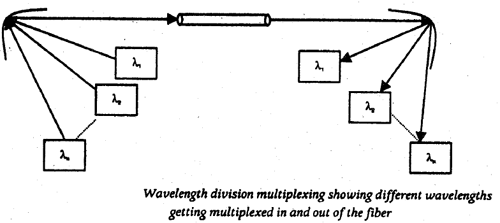Fiber optic technology is considered to meet the ever-increasing demand of bandwidth for the exchange of information and Wavelength Division Multiplexing (WDM) provides solutions for the ever-increasing demand of bandwidth through optical networks. In optical communication” the analog of FDM is referred to as wavelength-division multiplexing (WDM).
Wavelength division multiplexing (WDM) may be defined as the fiber-optic transmission technique that employs two or more optical signals having different wavelengths to transmit data simultaneously in the same direction over one fiber, and later on is separated by wavelength at the distant end. WDM allows transmission of analog or digital signals up to a few GHz or Gbits on a carrier’s very high frequency around 190 THz (infrared). In fact, using several carrier waves that are propagating without significant interaction on the same cable can increase the bit rate further. these carrier waves correspond to different wavelengths. This is the reason it is called Wavelength Division Multiplexing (WDM). The relationship between frequency and wavelength is given as follows:
λ = c/f
Where, c and f are the velocity and frequency of the signal in the medium.
λ1 λ2 λ3……… λn

In WDM several sources emitting at different wavelengths say λ1 λ2 λ3 and So on are coupled into the same optical fiber and these are separated after transmission on the fiber toward different detectors at the fiber end. Figure explains the technique of WDM.
The flow rates may reach in this way 10 Gbit/s on a single wavelength, with ramp-up expected soon to 40 Gbit/s or 160 Gbit/s. Even higher speeds have been obtained in the laboratory. A fiber 128 to wavelength of a 10 Gbit/s provides a total flow of 1.28 Tbit/s. This represents approximately 60 million telephone voice transiting the same time on the physical medium. In other words, the entire country population can call 60 million people at the same time using a single optical fiber.
The wavelength-division multiplexing can be performed on an optical star. In first experiments in this direction have started in the 1990s, especially at the research center Bellcore, the United States, with Lambdanet. This model using the wavelength-division multiplexing on the optical fiber. Several light beams were conveyed in parallel in the core of the optical fiber. Using a transmitter, was sent on a subchannel signals broadcast by a central star to passive sub-channels corresponding to connected nodes. For a total of 16 knots, there were a way to go and 16 return channels between a node and star. The width of each band possible to obtain a channel 2 Gb/s. The distance between the central optical star and users could reach 50 km.
 Dinesh Thakur holds an B.C.A, MCDBA, MCSD certifications. Dinesh authors the hugely popular
Dinesh Thakur holds an B.C.A, MCDBA, MCSD certifications. Dinesh authors the hugely popular